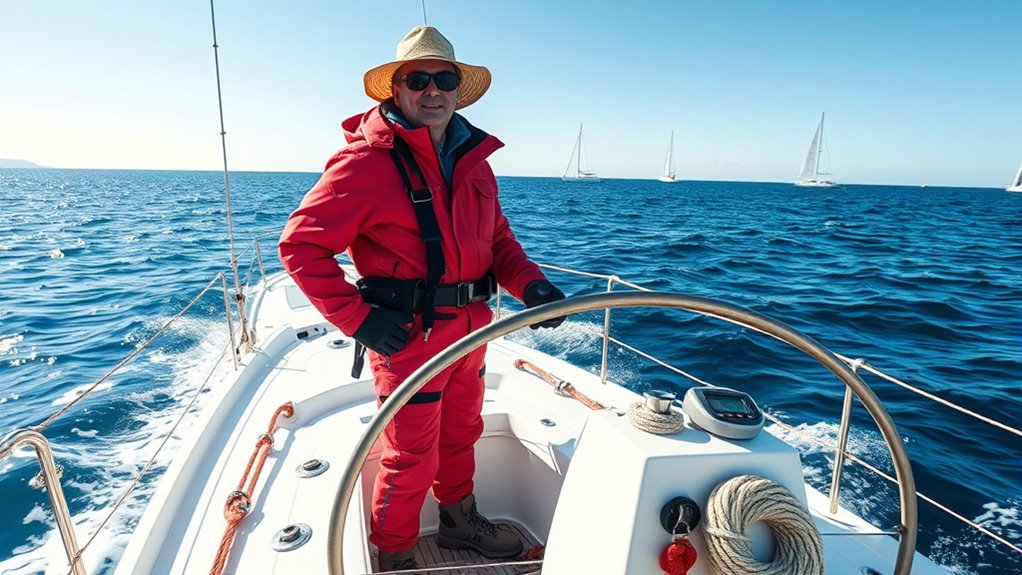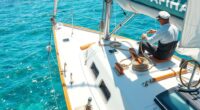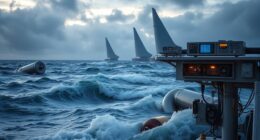Before you set sail solo, make sure your boat is thoroughly checked and all safety gear is onboard and functioning. Keep an eye on weather forecasts and be ready to adjust your route if needed. Wear life jackets, carry signaling devices, and ensure your communication tools like VHF radios and GPS are current. Practice emergency drills so you’re prepared for anything. Staying proactive and vigilant helps keep you safe—continue to explore more tips to sail confidently.
Key Takeaways
- Conduct thorough vessel inspections and verify all safety gear and communication devices are functional and accessible.
- Monitor weather conditions continuously, using reliable sources and recognizing signs of storms or hazards.
- Practice emergency drills for scenarios like man overboard, fire, or capsizing to build confidence and muscle memory.
- Plan routes carefully, including contingency options, and share your itinerary with trusted contacts.
- Regularly check and maintain all safety equipment, and stay updated on safety technology and best practices.
Prepare Your Vessel and Equipment
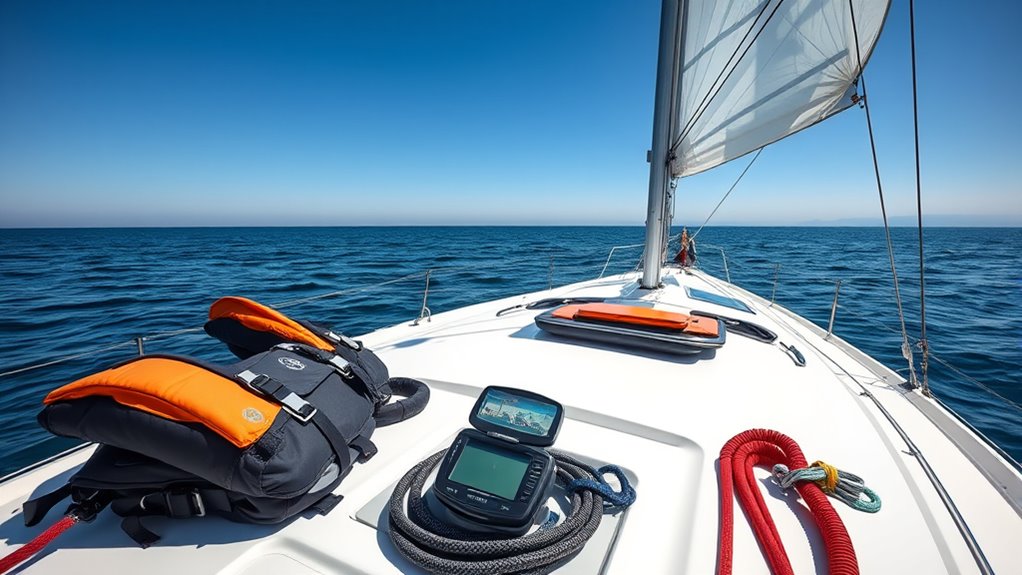
Before setting out on a solo sailing trip, you need to thoroughly prepare your vessel and equipment. Inspect your boat carefully, checking for any damage or wear that could cause problems at sea. Confirm all safety gear, like life jackets, flares, and a first aid kit, is onboard and in good condition. Test your communication devices, such as a VHF radio or emergency beacon, to verify they work properly. Secure loose items to prevent them from shifting or falling overboard during rough waters. Make sure navigation tools, including charts, GPS, and compasses, are up-to-date and within reach. Double-check your engine, sails, and rigging for peak performance. Proper preparation minimizes risks and helps you handle unexpected situations confidently. Proper planning is also an important factor to consider for visibility in different lighting conditions, ensuring you can navigate safely and effectively. Additionally, understanding market positioning and keeping abreast of competitor strategies can enhance your preparedness for unforeseen challenges.
Check Weather Conditions and Forecasts
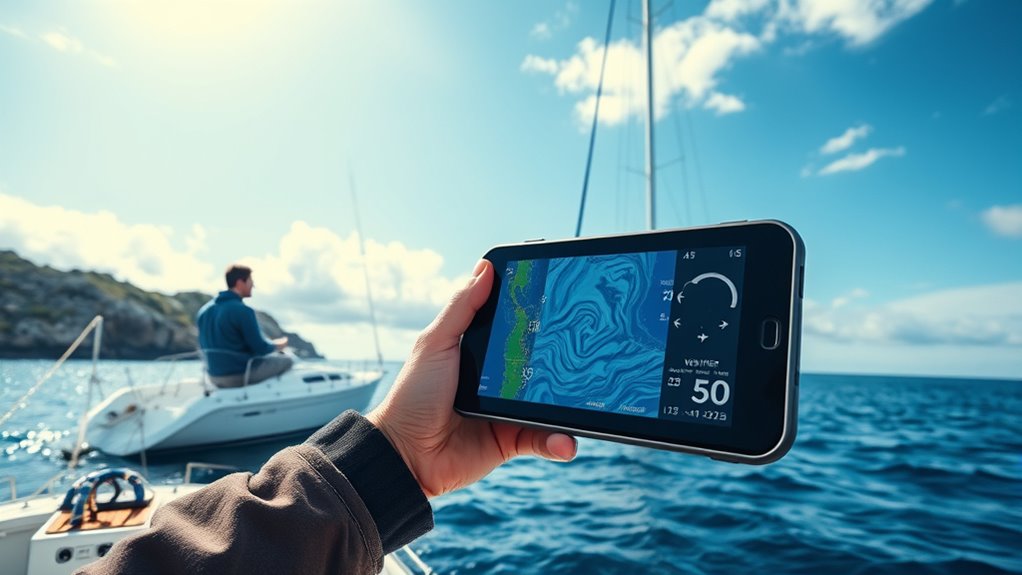
Always keep an eye on weather updates before heading out, and check them regularly during your trip. Understanding weather patterns helps you anticipate changes and plan accordingly. Be prepared for sudden shifts in weather to stay safe while sailing solo. Additionally, staying aware of natural phenomena can help you recognize signs of approaching storms or other hazards. Being familiar with weather forecasting tools can improve your ability to respond quickly to changing conditions. Remember that marine weather patterns can vary significantly depending on the season and location, so staying informed is crucial for safety. Recognizing sea state indicators can also aid in assessing current sailing conditions and potential risks. It’s also beneficial to understand how interior features of your vessel can influence safety and comfort in various weather conditions.
Monitor Weather Updates Regularly
Keeping a close eye on weather updates is essential when sailing solo, as conditions can change rapidly and unexpectedly. Continuously check weather forecasts before heading out and stay updated throughout your trip. Use reliable apps or marine radio broadcasts to receive real-time weather alerts, especially for sudden storms or high winds. Set up notifications on your devices to alert you to any warnings. Avoid sailing in uncertain or worsening conditions; if the weather starts to turn, be prepared to alter your course or seek shelter. Regular updates help you make informed decisions, ensuring your safety. Staying vigilant allows you to respond promptly to weather changes, reducing risks and keeping your solo voyage safe.
Understand Weather Patterns
Understanding weather patterns is essential for safe solo sailing because it helps you anticipate changing conditions and make informed decisions. Before setting out, check detailed weather forecasts from reliable sources. Learn to recognize signs of shifting weather, such as darkening skies, sudden wind shifts, or changes in barometric pressure. Familiarize yourself with common wind patterns and their typical behavior in your sailing area. Pay attention to local weather reports and listen to marine radio updates regularly while sailing. Recognizing weather patterns and their behavior allows you to plan your route better, avoid storms, and know when to seek shelter. Being proactive with weather knowledge minimizes risks and keeps you in control, making your solo sailing experience safer and more enjoyable. Additionally, understanding weather pattern behavior can help you better interpret unusual weather phenomena and respond quickly to emergencies. Incorporating AI weather forecasting tools can further enhance your ability to anticipate sudden changes. Staying informed about climate variations also prepares you to handle long-term weather fluctuations that may impact your sailing plans. Moreover, developing an understanding of local microclimates can be crucial for planning safe routes and avoiding unexpected weather surprises.
Prepare for Sudden Changes
Being prepared for sudden weather changes starts with checking the latest forecasts before you set sail. Always review updated weather reports from reliable sources, even if the forecast looks clear. Pay attention to wind speeds, storm warnings, and temperature shifts that could indicate changing conditions. Carry a portable weather radio or use a weather app on your phone for real-time updates. Plan your route with flexibility in mind, leaving early or choosing sheltered areas if storms are possible. Keep an eye on the sky and sea, and trust your instincts if conditions start to shift unexpectedly. Preparing for sudden weather changes ensures you can react quickly and stay safe, minimizing risks during your solo sailing adventure.
Wear Appropriate Safety Gear
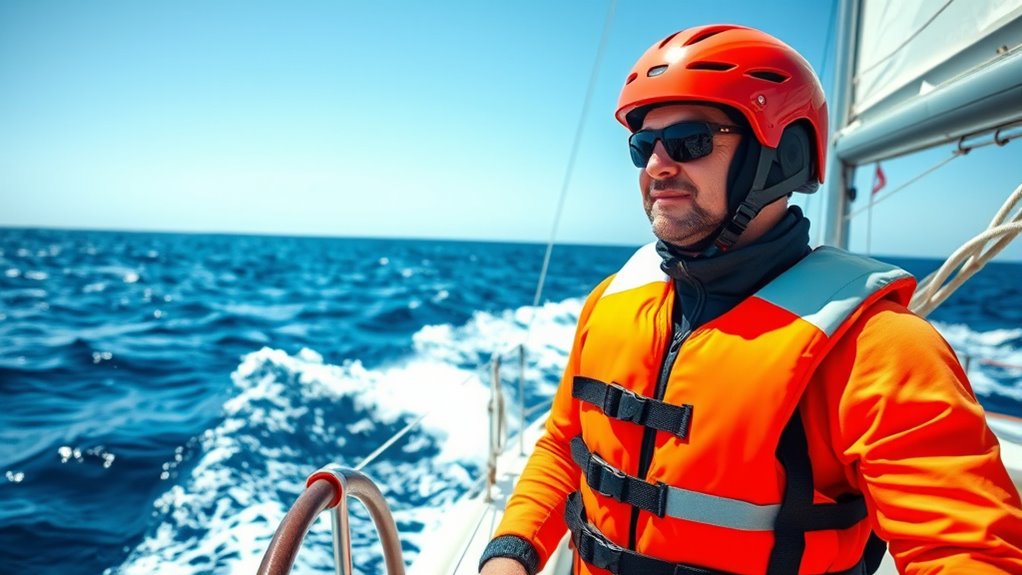
Wearing a life jacket is vital for your safety, no matter the conditions. Make sure you have emergency signaling devices onboard to alert others if needed. These safety gear essentials can make all the difference in an emergency situation. Additionally, being aware of recurring angel numbers during your journey can serve as spiritual guidance, providing reassurance and insight in challenging moments. Regularly inspecting your safety equipment ensures everything functions properly when needed.
Life Jackets Essential
When you’re sailing solo, don’t underestimate the importance of wearing a life jacket. It’s your primary safety tool in case of an accidental fall overboard or capsizing. Choose a life jacket that fits snugly and is approved for marine use. Ensure it’s comfortable enough to wear for extended periods, so you’re less likely to remove it. Always wear your life jacket properly secured, with straps tightened and the buoyant collar supporting your head. Remember, even experienced sailors can encounter unexpected situations. A life jacket increases your chances of staying afloat and being rescued quickly. Incorporating proper safety gear strategies into your safety planning can help you prepare for unforeseen emergencies. emergency preparedness into your routine can further enhance safety at sea. Never sail without one, and double-check your gear before heading out. Proper safety gear, starting with a reliable life jacket, is your best defense against emergencies at sea. Additionally, staying informed about industry transformations, such as advancements in safety technology, can provide critical benefits during your voyage.
Emergency Signaling Devices
Proper safety gear extends beyond life jackets; having reliable emergency signaling devices guarantees help is reachable when you need it most. Carrying devices like flares, whistles, and an emergency beacon ensures you can alert others during distress. Flares provide visual signals that can be seen from miles away, especially at night. Whistles are compact and effective for short-range alerting, while a GPS-enabled beacon can transmit your location instantly. Keep these devices accessible and in good condition, testing them regularly. Regularly inspecting your dog names and equipment ensures all devices function properly when needed. Here’s a quick overview:
| Device | Purpose | Best Use |
|---|---|---|
| Flares | Visual distress signal | Nighttime emergencies |
| Whistle | Audible alert | Short-range communication |
| Emergency Beacon | Location transmission | Long-range rescue |
| Signal Mirror | Reflects sunlight | Daytime visual signaling |
Having the right signaling gear can be the difference between rescue and prolonged distress, especially since inflation protection features in some safety devices can enhance your chances of being found quickly.
Maintain Communication and Navigation Devices
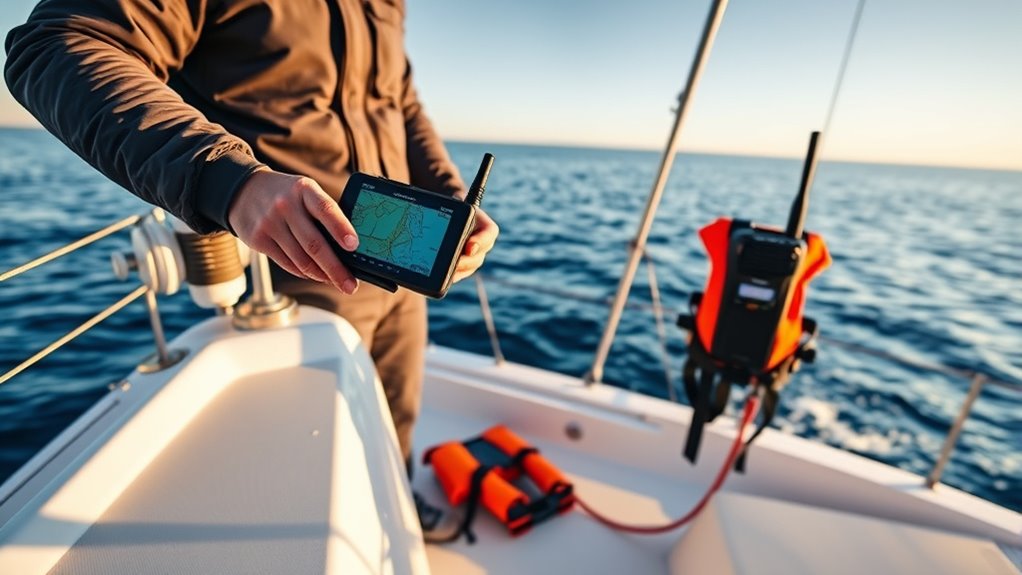
Ensuring your communication and navigation devices are functioning correctly is essential for solo sailing safety. Before setting out, check your VHF radio to confirm it’s working and fully charged. Test your GPS and backup navigation tools, such as paper charts or a handheld compass, to guarantee accuracy. Keep spare batteries or power banks onboard in case the primary devices run out of juice. Regularly update your devices’ software and settings to prevent malfunctions. Always store communication devices in waterproof, easily accessible locations. Familiarize yourself with how to operate all equipment quickly. By maintaining your devices diligently, you’ll be prepared to call for help if needed and navigate safely through changing conditions, reducing risks during your solo voyage.
Practice Emergency Procedures
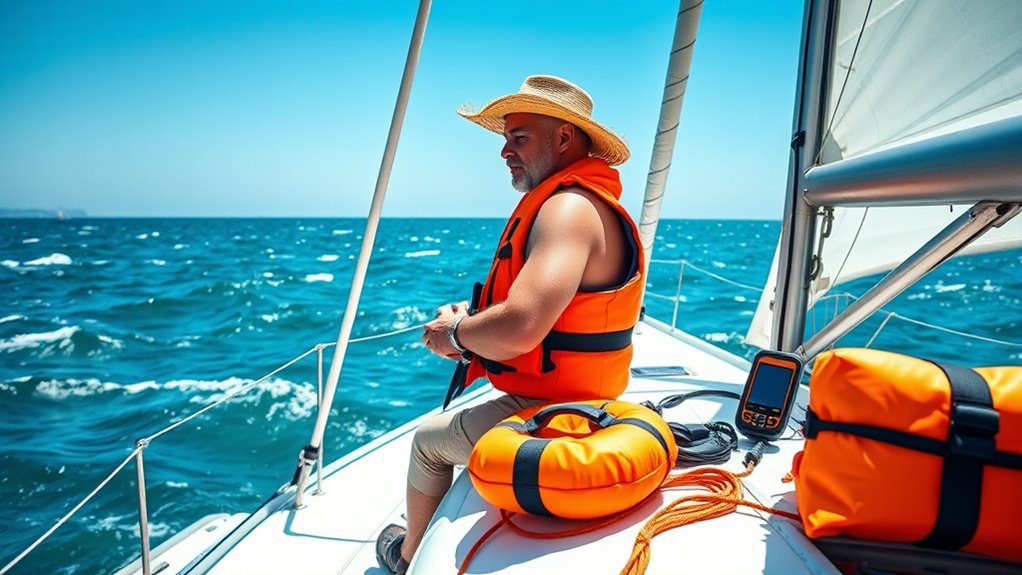
Practicing emergency procedures regularly is crucial for solo sailors to respond quickly and confidently in critical situations. You should simulate scenarios like man overboard, fire, or capsizing to familiarize yourself with your boat’s safety equipment and protocols. Conduct drills in calm conditions to build muscle memory, making your reactions instinctive when time is urgent. Always review how to properly operate safety gear such as life rafts, flares, and communication devices. Practice setting off distress signals and performing self-rescue techniques. Keep your emergency plan updated and ensure you understand each step thoroughly. Repetition is key; the more you practice, the less likely panic will impair your judgment. Preparedness boosts your confidence, helping you stay calm and effective during real emergencies.
Plan Your Route and Share Your Itinerary

Having a clear plan for your sailing trip and sharing your itinerary with others can considerably enhance your safety on the water. Before setting out, chart your route carefully, considering weather patterns, tides, and potential hazards. Know the locations of safe harbors or anchorages along your route, and plan for contingency options if conditions change. Share your itinerary with a trusted friend, family member, or marina staff, including your departure time, route, and expected return. Check in with them regularly via radio or phone if possible. This way, someone knows where you are and can alert authorities if you don’t check in as scheduled. Proper planning and communication ensure help can reach you quickly if needed, reducing risks during your solo sailing adventure.
Frequently Asked Questions
How Do I Handle Unexpected Mechanical Failures While Sailing Solo?
When facing unexpected mechanical failures while sailing solo, stay calm and assess the situation quickly. Use your knowledge of the boat to identify the problem, whether it’s a torn sail or engine issue. Follow your pre-planned emergency procedures, such as using backup systems or signaling for help if needed. Keep communication devices handy, and don’t hesitate to call for assistance if the situation worsens.
What Are the Best Practices for Preventing Seasickness During Long Trips?
To prevent seasickness during long trips, you need to stay hydrated, focus on the horizon, and keep your body steady. Avoid heavy, greasy foods that can upset your stomach, and take breaks to breathe fresh air. You should also consider motion sickness remedies like ginger or medication if you’re prone to nausea. Staying calm, relaxed, and well-prepared helps you enjoy your journey without seasickness disrupting your adventure.
How Can I Improve My Navigation Skills as a Solo Sailor?
To improve your navigation skills as a solo sailor, you should practice regularly with both electronic and traditional tools like charts and compasses. Take courses on celestial navigation and GPS use, and keep your skills sharp by planning routes in advance. Stay updated on weather patterns and maritime regulations. Don’t hesitate to seek mentorship or join sailing communities to learn from experienced sailors, ensuring confident and accurate navigation at sea.
What Should I Do if I Encounter Aggressive or Uncooperative Vessels?
Imagine your vessel as a gentle lighthouse in turbulent waters. When you face aggressive or uncooperative vessels, stay calm like the steady beam of light. Signal clearly, maintain a safe distance, and avoid escalation. Use your radio to communicate your intentions, and if needed, alter course to keep safe. Remember, your confidence and clarity act as a beacon, guiding you through risky encounters with resilience.
How Do I Stay Mentally and Physically Prepared for Extended Solo Voyages?
To stay mentally and physically prepared for extended solo voyages, you should develop a routine that includes regular exercise, proper nutrition, and sufficient rest. Keep your mind engaged with navigation, weather updates, and personal reflection. Practice stress management techniques like deep breathing or meditation. Stay connected with loved ones when possible, and always review safety procedures. Consistent preparation helps you maintain focus, resilience, and confidence during your journey.
Conclusion
Before you set sail into the unknown, remember that even the best preparations can’t eliminate every risk. Stay vigilant, trust your skills, and keep safety at the forefront. As you navigate open waters alone, the unexpected can happen when you least expect it. Are you truly ready for what lies ahead? Keep your wits about you, and your solo adventure can become a story of triumph — or a lesson learned the hard way.

